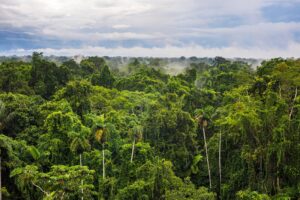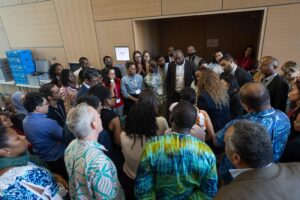
Interactive: Who wants what at the COP30 climate change summit
Multiple Authors
11.05.25Multiple Authors
05.11.2025 | 12:19pmNegotiators from around the world will soon descend on Brazil as it prepares to host the latest round of UN climate talks, on the banks of the Amazon river.
COP30 in Belém will see them discuss issues including the best ways to track progress on adaptation and how to pursue a global “just transition”.
Some of the event’s most important topics, such as countries’ new climate targets and raising international climate finance to $1.3tn, will officially take place outside the formal negotiations.
Nevertheless, these issues will likely drive much of the COP30 narrative.
In order to track parties’ positions on key negotiating points at the summit, Carbon Brief has analysed nearly 100 submissions to the UN and captured them in the interactive table below.
The first column in the table shows the countries and UN negotiating blocs, the second shows the topics up for debate and the third indicates specific issues within those topics.
The final column indicates the positions that the parties have expressed on each topic. These range from “priority” – meaning the party is likely to be pushing the issue – to “oppose”, meaning it is likely to push against it.
This is a “living document” that will be updated during the course of COP30.
Please get in touch if you would like to offer additions to the table by emailing [email protected].
Explanations of the overarching issues and jargon-filled language that permeate the talks can be found below the interactive table.
Adaptation
At COP28 in 2023, governments adopted a “framework” for the “global goal on adaptation”, which was originally included in the Paris Agreement, but had seen little progress till then.
Over the following two years, negotiators and experts have been discussing a list of measurable “indicators” that can be used to track global progress on adaptation.
At COP30, a final list of 100 of these indicators is expected to be adopted, making it one of the key concrete outcomes expected at the summit in Belém.
From an initial list of more than 5,000 potential indicators, a group of experts worked to refine this down into a set of around 500 in June. This has been reduced further to 100 proposed final indicators, which will be negotiated at COP30.
These indicators must be both specific enough to allow for accurate measurement of progress and versatile enough to apply to the vast array of location-specific adaptation practices.
Beyond the list of indicators, divergences between parties remain around the topics of the “Baku Adaptation Roadmap”, the concept of “transformational adaptation” and adaptation finance. (See the Carbon Brief Q&A on the adaptation indicators for more details.)
Climate finance
As ever, discussions of “climate finance” – the financial resources channelled into climate action in developing countries – are likely to feature prominently at COP30.
Last year, countries had a deadline to decide on a new global climate-finance target known as the “new collective quantified goal on climate finance” (NCQG), meaning this issue took centre stage at the COP29 negotiations.
In Belém, formal climate-finance negotiations are less prominent. However, the launch of the “Baku to Belém roadmap to $1.3tn” ahead of the summit will provide an opportunity for parties to reflect on the topic and may influence wider negotiations.
The roadmap was mandated last year, due to a view among developing countries that the NCQG’s main target of “at least” $300bn a year by 2035 was insufficient.
Parties and negotiating blocs have made 36 submissions to the Baku to Belém consultation process, outlining what they want to see reflected in the final roadmap.
While the submissions refer to the Baku to Belém outcome specifically, they tend to reflect countries’ broader positions on the topic of climate finance.
Familiar issues, such as developing countries calling for more grant-based finance and developed countries stressing the importance of the private sector, feature prominently.
(For more analysis of countries’ positions on the roadmap, see Carbon Brief’s explainer on this topic.)
Just transition and global stocktake
Besides climate-adaptation indicators, the COP30 presidency has highlighted two other negotiating strands as priorities – the “just transition work programme” (JTWG) and the “dialogue” on implementing the outcome of the first “global stocktake”.
The former refers to discussions between parties about how best to support those affected by the transition to a low-carbon world.
As for the stocktake dialogue, this involves taking forward the outcomes from COP28, where countries were called on to contribute to various targets, including “tripling” global renewable energy capacity and “transitioning away” from fossil fuels.
There remain fundamental differences between parties about the scope of both of these discussions.
Broadly within the JTWP, developing countries want to see a holistic transition that takes into account not just fossil-fuel workers, but the wider communities and groups impacted by the low-carbon transition, along with financial support from developed countries needed to underpin this.
Developed countries generally want to keep the negotiations focused on labour and how to share knowledge from “best practice” examples of transition management.
Within the stocktake dialogue, some large developing countries – particularly the Like-Minded Developing Countries (LMDCs) – want discussions to focus on climate finance.
Other developing countries and developed countries have pushed for a focus on climate ambition, including transitioning away from fossil fuels.
By the start of COP, nations are expected to have submitted their new climate plans under the Paris Agreement, known as nationally determined contributions (NDCs).
To date, only around one-third of countries have announced or submitted their 2035 climate pledges, covering roughly half of global emissions.
The ambition – or lack of it – contained in these plans will set the stage for talks in Belém.
COP reforms
A decade on from the Paris Agreement, many experts have voiced concerns about the way COPs work and called for various reforms. (See Carbon Brief’s “COP experts: How could the UN climate talks be reformed?”)
Some of these proposals – including major changes such as the introduction of majority voting – have come from outside the COP process.
However, the Brazilian COP30 presidency has brought some of these discussions into the formal negotiations under the heading of “arrangements for intergovernmental meetings” (AIM). Here, countries have the opportunity to discuss improvements in the way the COP operates.
Under AIM, some parties have suggested ideas for streamlining the COP process, such as reducing the number of items on the agenda, potentially through multi-year planning so that discussions at each summit are more focused, or through limiting the number of new issues that can be introduced.
Other ideas include, capping the number of participants allowed to attend each summit and giving a more formal status to the COP “action agenda”, where pledges from countries or other actors are often made, but not always tracked and followed up.
See Carbon Brief’s previous interactive tables showing “who wants what” at COP26, COP27, COP28 and COP29.



